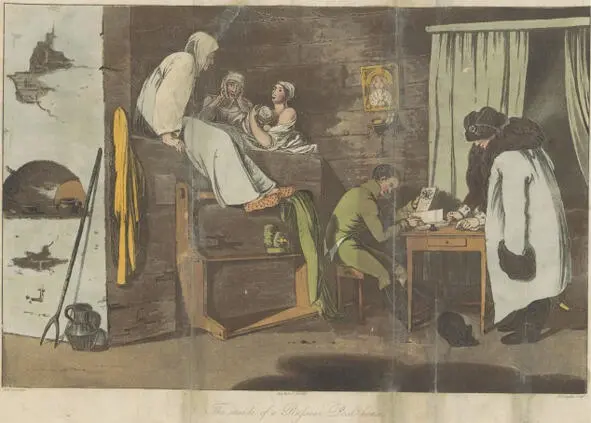
The painter Adele Ommer de Gel. Cossack picket, 40-s of the XIX century.
The first member of the Main Directorate of the Transcaucasus region, who at the same time was managing mail department, was a lieutenant general and well-known Georgian poet Knyazh Alexander Chavchavadze, who came to this post on December 28, 1842. [16]
Thus, in 1840 the Transcaucasian region post offices were transferred from the direct control of the Postal Department of the Empire under the jurisdiction of the Chief Executive of the Transcaucasian region. The law of 1840 stated: “… the agencies, which are subject to special control, such as customs, educational and mail agencies, are under dependence and supervision of the Chief Executive of the Transcaucasian region which relating these agencies operates on the basis of regulations and rules, in particular for each of these existing agencies.” [17]
The final withdrawal of the twelfth postal district from under the control of Postal Department and all the functions to manage all the Agencies were transferred to the main authorities of the Transcaucasian region at the vicegerent graph M.S.Vorontsov.
In January 1845, when M. Vorontsov was appointed the vicegerent of the Caucasus, his authorities were determined by a special rescript of Nicholas I: “having laid on you, along with the title of Commander-in-chief of the troops in the Caucasus, the main command of the civil part in the region, as my vicegerent and consider it necessary, for the good of the service, to strengthen the authorities, which until now have been given to the chief superintendent of civil section, I, in my full confidence to you, command: all the cases, which according to currently existing order have to be submitted on behalf of the Chief Directorate of the Transcaucasia region to the Ministry to be solved, should be solved in place. Moreover, you are provided with an authority, when you find it necessary, to take all the measures required by the circumstances, in place, reporting to me directly all your actions, as well as the reasons these actions were caused by” [18] With this document the power of Knyazh Vorontsov was extended to the Caucasian region (later renamed in the Stavropol province by the decree to the Senate on May 2, 1847).
The vicegerent of the Caucasian region, Mikhail Vorontsov was a good administrator and a talented Russian official. He was born and brought up in England, where he received an excellent education. When he was the Head of the region postal roads were being laid and the bridges were being built. At the same time Tbilisi became a large administrative center, the city’s population increased, there appeared is a large number of beautiful new public and private buildings. All of this strongly demanded to improve postal service.
Table 2 illustrates the movement of mail only for the city of Tiflis in 1855. It shows the development of the cultural needs of the population of the Caucasian capital, which was primarily military and bureaucratic, in terms of coverage the city with postal services.

Table 2. The number of sent and received correspondence at the Tiflis province post office for 1855. [19]
Interesting statistics of the XIX century: in the late 50s for 100 inhabitants of the cities of the former Russian Empire there were 12,3 sent and received messages a year; for 100 inhabitants of the city of Tiflis there were 36 sent and received messages and in England for 100 inhabitants there were 300 messages. [20]
A cardinal measure, which contributed to the development of postal services, was the fact that postal stations of Tiflis province and the city of Tiflis had been withdrawn from the jurisdiction of the County Police and transferred as an experiment under the management of the postal authorities of the Caucasus for three years. This governmental action took place on October 26, 1857. [21]
The regional administration tried hard to facilitate the use of public postal services for the population. For example, there were declared opening and closure hours of post offices in the postal regulations of that time. But from “travelling persons, those who were not constantly living in the cities, such as neighboring landowners, farmers and roundabout residents” – letters were accepted at any inopportune time. [22]
I.I.Nazarov, appointed the member of Chief Management Board of the Trans-Caucasian Region and Manager of the postal department on January 1847, began to be called “Manager of postal department of the Caucasus and beyond the Caucasus.” In this position he replaced the Knyazh A.G.Chavchavadze. [23]

The painter Sir Robert Ker Porter. The interior of Russian post station, 1813.
However, the authority given the to the vicegerent M. Vorontsov by the Tsar, had been fully used by him only in 1848 in the process of reforms carried out in the post office of Tiflis province.
Since the 70s of the XVIII century in Russia there formed a system of postal services and transportation of the passengers by “mail”, which was almost unchanged until the middle of XIX century. Postal relays (stations), arranged at the expense of the state, were given to the individuals to be maintained. They had to have 25 horses, 10 wagons on wheels or sled at every station, as well as all the equipment necessary for postmen and mail transportation (horse harness, suitcases, bags, saddles, uniforms of postmen). A stationmaster was also responsible for hiring postmen. Even the serfs, released on the rent by the landlord, were allowed to be hired for this tedious service. The revenues of the postal station keeper consisted of the statutory fee (12 kopecks per 10 verst’s), proceeds from the sale of food and alcoholic beverages at the post office, from the placement of travelers for the night. Everything, which concerned the work of the post office, subjected to strict state regulation.
In winter and in summer the couriers were to be driven with a speed of 12 versts an hour, and in autumn and spring – 11 verst’s an hour. Other travelers were ordered to be driven more slowly: in winter and summer – 10 v/h, and in the spring and autumn – 8 verst’s an hour. Everyone who enjoyed the services of the post office, as well as all the correspondence was recorded in a special logbook.
In the reign of Emperor Nicholas I, vigorous measures had been taken to put in order earlier considerably neglected system of postal communications and postal stations. In 1837 he visited the Caucasus and signed a decree on the construction of mail houses every 3—4 postal stations on the Caucasian tracts. Along with the intensification of the movement of postal crews, the government of Nicholas I sought to establish a permanent staff of postal employees and station keepers. On these purposes the lease period of postal stations was increased from 3 to 12 years, and the rental amount was to be determined not at the auction, but according to official estimates fixed for each post office. In Nicolas’s list of activities to improve the situation in the Russian Empire there was the item of constructing on the main road’s postal stations uniform in appearance and convenient for travelers.
Читать дальше















